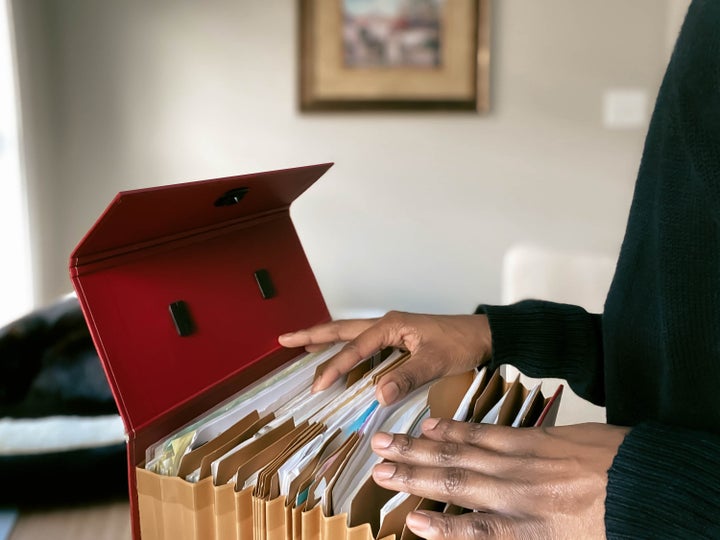When it comes to decluttering, it can be hard to decide exactly what to get rid of and how to organise so your house actually stays neat. Should you ditch souvenirs? What about product manuals and boxes? Are there particular organising systems that can actually make maintaining tidiness more difficult?
We asked professional organisers about the one thing they refuse to keep in their own homes and why that makes a significant difference in keeping their spaces clutter-free.

Souvenir and promotional cups
Whether you’ve kept a souvenir cup from every sentimental event you’ve been to or you frequently accept promotional cups just because they’re free, a lot of us have a kitchen shelf crowded with these.
“Plastic logo cups … are cheaply made and a nightmare to contain because they come in mismatched shapes and sizes,” Mindy Godding, owner of Abundance Organizing, told HuffPost. “Because they are lightweight, they easily fall over and get rowdy inside cabinets.”
She tries to not accept something just because it’s free and considers whether it serves her before bringing it into her home.
As for keepsake cups, these can be harder to part with — even if they’re rarely used: “I’ve learned that … we project emotional importance onto inanimate objects [like souvenir cups] because the item triggers a memory or story,” Godding explained.
She finds ways to separate the story from an item, like preserving special memories through photos or videos instead.
Product boxes
Boxes for large appliances, laptops, kitchen gadgets and other products can be particularly bulky — and frankly, none of them are needed, said Jennifer Truesdale, CPO and founder of Str8Nn Up Professional Organizing Services.
“These boxes … can take up valuable real estate over priority essential needs for your home,” she explained. “Also boxes stored in attics and garages can create places for bugs to nest.”
Instead, she suggests snapping a photo of the product name, model number, receipts, and other important information and storing it on the computer or a backup hard drive.
Some good quality boxes (like from iPhones) can be used to organize drawers or other areas, but Truesdale only recommends saving them if you have an immediate need.

User manuals
“In my home, user manuals are a no-go,” said Allison Flinn, CPO at Reclaim Professional Organizing. “They create unnecessary paper clutter. Less paper means less piles.”
Oftentimes, the user manuals or videos on how to fix a particular product issue can be found online so there’s no need to keep the paper version.
Clothes you no longer wear
Whether the clothes no longer fit or are torn or stained beyond fixing, Lori Reese, owner and founder of Consider It Done, said these can take up prime closet space.
“I have to be honest with myself: Am I really going to get that stain out, get that hole repaired, or fit into it again?” she explained. “If I never pare down, I’d run out of space and once it goes into storage, it’s forgotten. I don’t want to store things I no longer use.”
She recommends donating clothes that are still in good condition. As for clothes that are stained or torn, some organisations will even accept these for recycling so you don’t have to throw them away.
Junk mail
Junk mail can quickly turn into piles of unnecessary papers around your house.
Liz Jenkins, owner of A Fresh Space, said she actively works to reduce it by opting for digital statements and using Paper Karma, an app that helps you unsubscribe from junk mail.
“For anything that does come in the mail, it immediately goes in the recycling bin before it even makes it to my desk.”
Large storage totes
“For me, storage bins that are massive are useless,” said Gayle Goddard, owner of The Clutter Fairy. “Once you fill them with stuff, they become almost impossible to lift.”
Beyond that, large boxes are often hard to fit in closets, cabinets and other storage spaces in your home.
Goddard prefers to use stackable smaller boxes because they are easier to manage and can fit in closet spaces. She uses clear boxes with large labels so she can quickly find what’s in each one. And for holiday items, she says colour coding can work well, like using orange and black boxes for Halloween decorations.

Overly complicated organising systems
“Most products that use the word organising or productivity are just too complicated,” shared Ben Soreff, partner in House to Home Organizing. “If those systems are not easy, people won’t keep up with the habit.”
One of the worst offenders? Accordion files, according to Soreff. Not only is it difficult to put items in and pull them out, but they are not flexible or adaptable. “The accordion file is fixed and does not allow for a category to grow. … It creates a sense of permanency for paper we probably don’t need to hold on to anyway.”
The bottom line: Make changes that work for you
The most important thing to remember when organising your space: Think about your own routines and what is sustainable. Jeffrey Phillip, an interior designer and professional organiser, said he focuses on being mindful of what he already has, what’s coming in, and what needs to leave his home.
“By making it a lifestyle, the editing, decluttering, organising, tidying … is simply part of my everyday routine,” he said. “This allows me to more quickly and easily keep the organisation in place and keep my home tidy.”